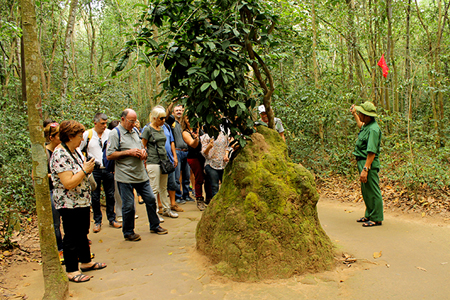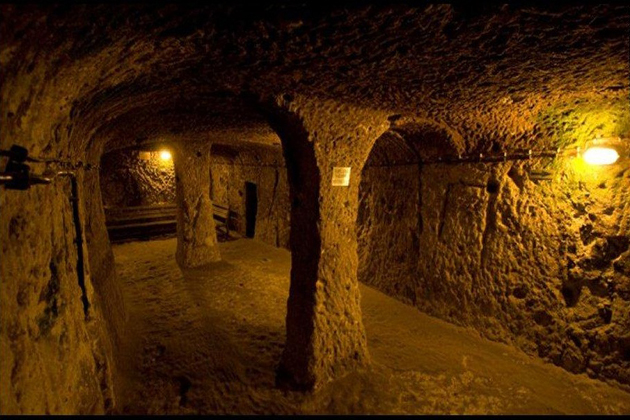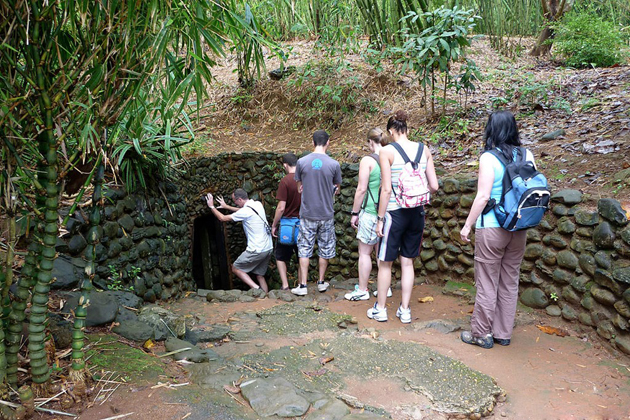Cu Chi Tunnels is an underground defense system in Cu Chi District, 70 km north-west of Ho Chi Minh City. This system was excavated by the Viet Minh and the National Front for the Liberation of South Vietnam during the Indochina War and the Vietnam War. The tunnel system includes infirmaries, rooms for living, kitchens, storage rooms, and offices. The tunnel system is about 250 km long and has ventilation systems at the bushes. Cu Chi tunnels are built on land known as "steel land", located at the end of the Ho Chi Minh Trail. During the Tet Offensive of 1968, the National Front for the Liberation of South Vietnam used this tunnel system to attack and liberate Saigon.
The History of Cu Chi Tunnels
Cu Chi Tunnels was a common name different tunnels, formed from the period 1946-1948, during the Indochina War. In this period, the system was short tunnels with simple structures used to hide documents and weapons.
By 1965, about 200 km of tunnels were excavated. In terms of scale, the tunnel system had a total length of over 200 km, with 3 different floors. The upper one was 3m deep from the ground floor, the middle one was about 6m while the bottom floor had a depth of 12 m from the ground. At this time, the tunnel played a role not only a shelter but had become a place of living, ambulance, meeting, weapon depot.
The Unbelievable Existence of Cu Chi Tunnels in the Underground of Enemy's Capital
Ironically, ignorant of the existence of the tunnels, US military installed a large base camp right on top of the network. It took them months to figure out why, at night, soldiers were being shot right in their tents. The Americans and Australian tried a variety of methods to pacify the area around Cu Chi, at that time known as the Iron Triangle. But neither bombs, napalm, defoliant, hunting dogs, nor tunnel rats were successful in driving Viet Cong guerrillas away. In 1969 the Americans decided to carpet bomb the whole area with B-52s, turning the area into what has been described as 'the most bombed, shelled, gassed, defoliated and devastated area in the history of warfare. Although they managed this time to destroy most of the tunnel network, along with everything else around, it was too late: the war was ending and the tunnel had been an important component of the Viet Cong victory.
Rules for Visiting Cu Chi Tunnels
With a view to ensuring the safety for visitors at Cu Chi Tunnel, you must follow some rules:
Visitors should strictly comply with our attendants’ instructions. During the visit you should not leave your Group or go down the tunnel alone without an attendant.
You should not go down the tunnel in the following cases:
Visitors have a past medical history about a cardiovascular disease, high blood pressure, or such respiratory diseases as asthma, tuberoulosis…, arthritis, rheumatism.
Visitors are afraid of darkness and narrow place.
Visitors of old age (70 years old or more)
Visitors got drunk on alcohol or beer.
For visitors’ safety, we request visitors should strictly comply with these rules, falling which, our Cu Chi Tunnel Authority shall not assume any responsibility.






The two most famous tunnel systems built by the North Vietnamese are Vinh Moc and Cu Chi. The villagers of Vinh Moc were only a few kilometers north of the DMZ in what the US military called a ‘free-fire zone’. Under the constant attacks of bombardiers and artillery, they switched from small family shelters to deeper dugouts. The red clay terrain provided excellent conditions and soon the entire 1,200 inhabitants permanently migrated from the surface to the 2.8 km tunnel system complete with kitchens, clinics, school, wells, ventilation shafts… DON’T miss this site. The tunnels have been left in their original condition and size (unlike the tunnels at Cu Chi) and the local guides (essential if not to get lost in this underground maze) are knowledgeable and informative. A visit to the Vinh Moc tunnel system might prove daunting for people with claustrophobic tendencies. And if you’re not sure, it certainly will be a good way to evaluate your ranking on the fear-of-enclosed spaces scale. A milder, but still fascinating experience is a visit to the Cu Chi tunnel system. The site has been specially restored for tourists with a small cinema room, guides that will accompany you along the prepared circuit, displays of all types of traps used by the North Vietnamese fighters, enlarged sections of tunnel to accommodate foreign tourists, examples of tanks and other military equipment and even a shooting range where you can try antiquated US, Russian and Chinese rifles.